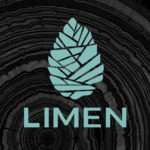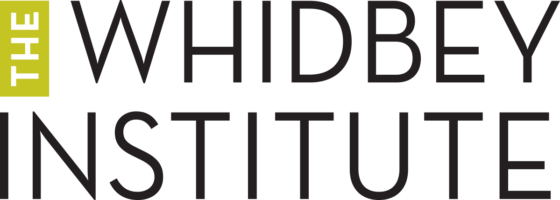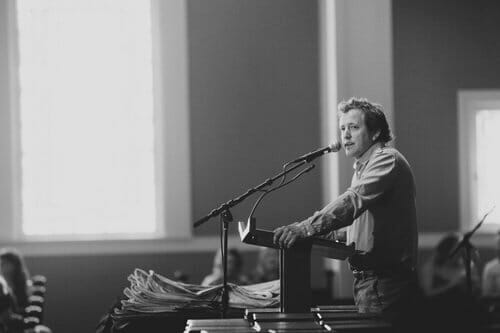I recently connected on the phone with Joel de Jong, a board member since October 2017 and lifelong entrepreneur, to talk about work, community service, and his Whidbey Institute board involvement. You may have seen his Emerging Future Podcast shared in our newsletters. While we spoke, Joel was tromping through Cheasty Greenspace southeast of downtown Seattle. Here’s our interview. —Marnie Jackson
What’s your background?
My work background is somewhat untraditional and entrepreneurial. Right out of college, I started a business to screen student athletes for heart conditions. I did that for about a decade—and meanwhile, I was also driving a garbage truck. Through winning a business plan competition at Seattle University while pursuing an MBA, I started another business. I’ve always taken a non-traditional approach to career, with a throughline of curiosity. I strive to make meaning for my own life, and to have an impact in a meaningful way in the world. That’s the career side—I also have a service aspect to my life. At this moment, I’m walking in Cheasty, the 43-acre urban woods behind our house that we’ve been helping restore. This project has been a deep dive into community, place, and family, and this kind of service is in the heart of our family culture.
Can you tell me more about Cheasty?
Cheasty Greenspace is the largest contiguous forest in the Rainier Valley within the most diverse zip code in the country. We live near the space, and when we first started interacting with it, it was overrun with invasive species, homeless encampments, gunfire, prostitution, and drugs. We partnered with the Green Seattle Partnership*, formed a neighborhood volunteer group, and started restoring the space through an ecological lens. Momentum and activity of restoration ended up being the catalyst for community growth and development in and around the space. It has united the community, given people a reason to leave their houses and get outside, and supported people in engaging with the land.
Cheasty is in an urban corridor: under the flightpath, near the light rail, and near main arterials. Right now, I’m hearing human sounds. While this is a place to reconnect with nature, there’s also a deep rooted social aspect to being here because of its urban context. Humans should have access to nature! It’s a human right. When large public spaces like Cheasty are uninviting and inaccessible, with no engagement, it is a disservice to the people. We partnered with the city to create a trail system and provide access for the community. We host restoration parties twice a month and have ten acres of restored forest with 33 more acres that have been in restoration since 2014. There’s an extensive trail system coming soon. It’s in the final stages of planning with the city and labeled a pilot project to include Seattle’s first forested mountain biking trails.
When you transform a space through design, it supports people interacting with people and interacting with place. It allows the space to become what it’s supposed to be—safe and welcoming. One might want to measure how it affects crime or related behaviors. There’s currently no gunfire and less garbage dumping in Cheasty.
Cheasty now has visually appealing entrances and welcoming signage, and people who haven’t seen it before might walk in and think it’s always been like this. We let the woods take it from there. Being in nature has so many benefits; it reconnects us to our truer selves and the interrelatedness of all things, and provides a wonderful example for communal flourishing.
What else would you want readers to know about you?
I’m a musician. I love music and the arts, and at some point all of those things intersect and create me.
I’m married to an eco-theologian who’s deeply rooted in theology and place, in reconnecting to nature. That ultimately informs our family culture and comes through in our values. We have four kids, Orion is 12, River is 11, Anna is seven, and Cannon is three. My family gives me a deep sense of responsibility to intentionally create the present reality that we all need to bring us into a flourishing future. I know my children are going to be here longer than me, God willing. We need to create a life that is meaningful, and give them the best opportunity to sense into all of the richness that our life holds. To connect with the forest and with the community, and to do it in a loving way. Overall, I focus on doing everything with joy as the driving energy force, even when we’re doing hard things. As a parent, I enjoy my children. I don’t just show them my strengths. I reveal my weaknesses and failures as well, to be vulnerable with them and to teach them to go for it in the face of failure.
How has Whidbey Institute board service felt for you so far?
I appreciate how the Whidbey institute is looking at and focused on intersectional work, looking at big picture ecological problems as well as at individual human development. I’m fascinated by the part of the work that’s rooted in Thomas Berry’s perspective, and how it lands itself particularly in the Whidbey Institute land. I’m excited by this interest in exploring nature and the cosmos, and how that informs the way that we behave, as well exploring our inner world, looking into our deep selves and our own souls.
Since joining the board, the whole idea that this is a deliberately developmental organization has really resonated with me. Barbara [Schaetti] and I have synced up to support staff and board in having quarterly learning events. I see there being a kind of posturing toward an evolutionary approach for the Whidbey Institute itself. That’s healthy, and creates opportunity to always be growing, always learning. I like the way this organization invites and includes. While we don’t know everything or have everything figured out, we know all are invited into the work with us.
Can you speak to how you connected with the Whidbey Institute before you joined the board?
The founder, Vivienne Hull, mentored my wife Mary as she was evolving her understanding of religion and Celtic Spirituality. Mary and Vivienne are good friends.
 The idea of my Emerging Future Podcast was anchored in a meeting at the Whidbey Institute. I was already sensing the need to start something like it. When Heather invited me to a dinner salon and each person shared their unique stories about how they were a force for good in the world, I walked away knowing some of the people in that room were who I would kick off the podcast with. It helped me solidify that the emerging future theme for the podcast.
The idea of my Emerging Future Podcast was anchored in a meeting at the Whidbey Institute. I was already sensing the need to start something like it. When Heather invited me to a dinner salon and each person shared their unique stories about how they were a force for good in the world, I walked away knowing some of the people in that room were who I would kick off the podcast with. It helped me solidify that the emerging future theme for the podcast.
I use the emerging future as a lens for how I approach my work. The name of my business is Limen, which means threshold, and is used in the phrase liminal space. I think of liminal space as when you are able to carry past, present, and future tenses all at once. Essentially it’s a moment of clarity and maturity that brings us into a deeper and more expansive sense of what’s happening, and what’s needed in this present moment. When you experience a limen moment there’s an undeniable truth to it beyond what you can actually see and touch. It’s a deep knowing.

Limen is a consulting business, largely in digital marketing space. I’m helping people develop their communication and strategy. Communication often involves a lot of externalization, messaging going out about what someone wants people to think about the business. I help clients root their messaging in the deeper truth about why they’re gathering and doing what they’re doing—the authentic purpose driving their business.
I also recently became a partner at Evolution at Work, a for-purpose enterprise focused on helping people and organizations—particularly in self organizing entities—develop capacities for complexity in the new world of work.
Is there anything else you’d like to share?
 I’d like people to know about Crowdsource Choir, something I launched in January with the goal of reinventing choir for the 21st century and recovering singing as a core cultural competency. It’s a drop-in choir with no tryouts. We gather on a monthly basis and sing popular songs without the historical baggage of the overtly religious songs that might turn people off. Crowdsource Choirs strive to bring an enlivened sense of community through singing and removing barriers to participation.
I’d like people to know about Crowdsource Choir, something I launched in January with the goal of reinventing choir for the 21st century and recovering singing as a core cultural competency. It’s a drop-in choir with no tryouts. We gather on a monthly basis and sing popular songs without the historical baggage of the overtly religious songs that might turn people off. Crowdsource Choirs strive to bring an enlivened sense of community through singing and removing barriers to participation.
Singing is one of the most ancient things we all share as humans. In modernity, however, the singing experience has been hijacked by recorded music and the institutions that are broadcasting those sounds. We end up hearing only the very best auto-tuned voices in the world, wherever we go. Those artists are celebrated and then we pay a lot of money to see their act, which creates financial barriers to entry and a growing divide between performer and spectator.
Crowdsource Choir narrows that divide by creating a culture of participation and a safe space for people to use their voice on behalf of a greater whole. Choir is such a wonderful metaphor for how we can participate with what is uniquely ours and create a harmonious and beautiful sound with others. I first had the idea of Crowdsource Choir after taking Robert Gillman’s course, Bright Future Now, in which it was mentioned that humanity has begun to lose aspects of our humanity, like music, art, singing, and dance, that once brought communities together. In many ways we’ve lost our individual voices as well as our collective song. The voice is the first instrument, and singing as an ancient human activity can be recovered in a relevant way to bring a renewed sense of joy and belonging into our communities today.
We’ve held two monthly gatherings thus far, with about 30 people at one and 40 at another. I think it will grow.**
_______________________
* Green Seattle Partnership is, “a collaboration between the City of Seattle, Forterra, community groups and non-profits, businesses, schools, and thousands of volunteers working together to restore and actively maintain the City’s forested parklands.”
**Crowdsource Choir meets the first Thursday of every month. https://www.facebook.com/crowdsourcechoir/

